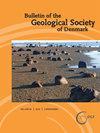使用卷积神经网络绘制白垩纪断层图-丹麦北海的一个现场示例
IF 1
4区 地球科学
Q2 Earth and Planetary Sciences
引用次数: 0
摘要
断层图为地震勘探、储层划分特征和盖层完整性的许多方面提供了必要的信息。然而,由于有限的分辨率和地震噪声,从地震数据中手动解释断层既耗时又具有挑战性。在这项研究中,我们应用卷积神经网络对具有平面断层形状的合成地震数据进行训练,以改进丹麦北海Valdemar油田下白垩统和上白垩统剖面的断层作图。我们的目标是评估神经网络模型在Valdemar油田叠后地震数据上的性能。与方差和反蚁跟踪属性以及人工断层解释的比较表明,神经网络预测断层的细节更多,这可能会提高对研究区域整体地质和构造的理解,并增加以前被忽视的潜在分区信息。然而,神经网络对地震噪声很敏感,这可能会使断层预测失真。因此,所提出的模型应被视为一个额外的断层解释工具。尽管如此,该方法代表了一种最先进的断层测绘工具,可以用于油气勘探和二氧化碳储存地点评估。本文章由计算机程序翻译,如有差异,请以英文原文为准。
Mapping Cretaceous faults using a convolutional neural network – A field example from the Danish North Sea
The mapping of faults provides essential information on many aspects of seismic exploration, characterisation of reservoirs for compartmentalisation and cap-rock integrity. However, manual interpretation of faults from seismic data is time-consuming and challenging due to limited resolution and seismic noise. In this study, we apply a convolutional neural network trained on synthetic seismic data with planar fault shapes to improve fault mapping in the Lower and Upper Cretaceous sections of the Valdemar Field in the Danish North Sea. Our objective is to evaluate the performance of the neural network model on post-stack seismic data from the Valdemar Field. Comparison with variance and ant-tracking attributes and a manual fault interpretation shows that the neural network predicts faults with more details that may improve the overall geological and tectonic understanding of the study area and add information on potential compartmentalisation that was previously overlooked. However, the neural network is sensitive to seismic noise, which can distort the fault predictions. Therefore, the proposed model should be treated as an additional fault interpretation tool. Nonetheless, the method represents a state-of-the-art fault mapping tool that can be useful for hydrocarbon exploration and CO2 storage site evaluations.
求助全文
通过发布文献求助,成功后即可免费获取论文全文。
去求助
来源期刊

Bulletin of the Geological Society of Denmark
GEOSCIENCES, MULTIDISCIPLINARY-
CiteScore
2.80
自引率
16.70%
发文量
28
审稿时长
>12 weeks
期刊介绍:
The Bulletin publishes contributions of international interest in all fields of geological sciences on results of new work on material from Denmark, the Faroes and Greenland. Contributions based on other material may also be submitted to the Bulletin if the subject is of relevance for the geology of the area of primary interest.
 求助内容:
求助内容: 应助结果提醒方式:
应助结果提醒方式:


